Formula C6H6O Density 1.07 g/cm³ IUPAC ID Phenol Soluble in Water | Molar mass 94.11124 g/mol Boiling point 181.7 °C Melting point 40.5 °C | |
 | ||
Related compounds | ||
Phenol, also known as carbolic acid, is an aromatic organic compound with the molecular formula C6H5OH. It is a white crystalline solid that is volatile. The molecule consists of a phenyl group (−C6H5) bonded to a hydroxyl group (−OH). It is mildly acidic and requires careful handling due to its propensity to cause chemical burns.
Contents
- Properties
- Acidity
- Phenoxide anion
- Tautomerism
- Reactions
- Production
- Uses
- Niche uses
- History
- Second World War
- Natural occurrences
- Occurrence in whisky
- Biodegradation
- Toxicity
- Phenols
- References
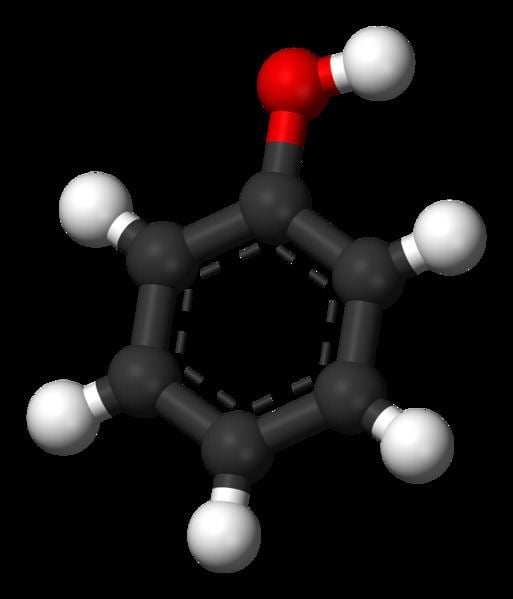
Phenol was first extracted from coal tar, but today is produced on a large scale (about 7 billion kg/year) from petroleum. It is an important industrial commodity as a precursor to many materials and useful compounds. It is primarily used to synthesize plastics and related materials. Phenol and its chemical derivatives are essential for production of polycarbonates, epoxies, Bakelite, nylon, detergents, herbicides such as phenoxy herbicides, and numerous pharmaceutical drugs.

Properties

Phenol is an organic compound. Phenol is appreciably soluble in water, with about 84.2 g dissolving in 1000 mL (0.895 M). Homogeneous mixtures of phenol and water at phenol to water mass ratios of ~2.6 and higher are possible. The sodium salt of phenol, sodium phenoxide, is far more water-soluble.
Acidity
Phenol is weakly acidic and at high pHs gives the phenolate anion C6H5O− (also called phenoxide):
PhOH ⇌ PhO− + H+ (K = 10−10)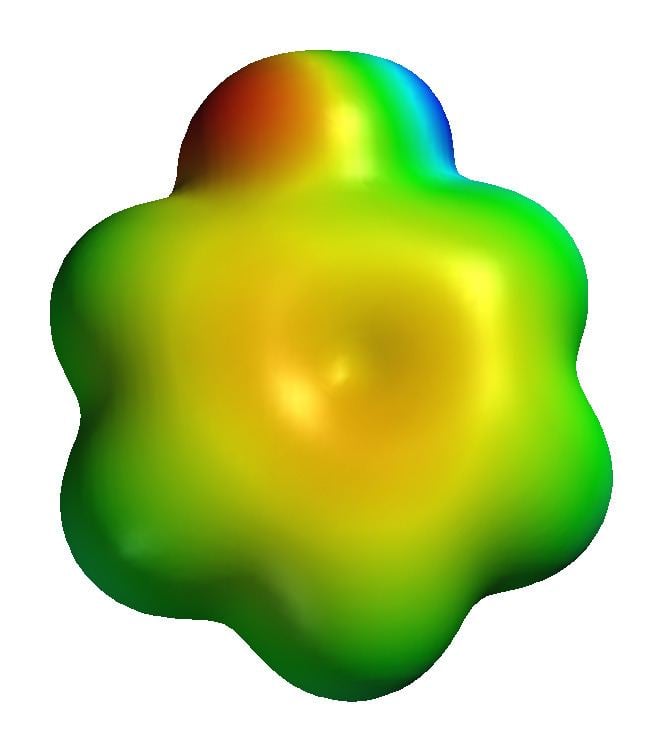
Compared to aliphatic alcohols, phenol is about 1 million times more acidic, although it is still considered a weak acid. It reacts completely with aqueous NaOH to lose H+, whereas most alcohols react only partially.
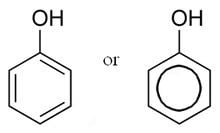
One explanation for the increased acidity over alcohols is resonance stabilization of the phenoxide anion by the aromatic ring. In this way, the negative charge on oxygen is delocalized on to the ortho and para carbon atoms. In another explanation, increased acidity is the result of orbital overlap between the oxygen's lone pairs and the aromatic system. In a third, the dominant effect is the induction from the sp2 hybridised carbons; the comparatively more powerful inductive withdrawal of electron density that is provided by the sp2 system compared to an sp3 system allows for great stabilization of the oxyanion.
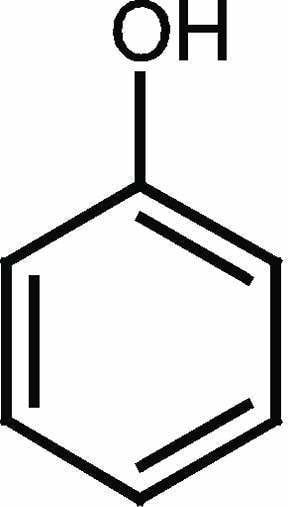
The pKa of the enol of acetone is 10.9, comparable to that for phenol. The acidities of phenol and acetone enol diverge in the gas phase owing to the effects of solvation. About 1⁄3 of the increased acidity of phenol is attributable to inductive effects, with resonance accounting for the remaining difference.
Phenoxide anion

The phenoxide anion has a similar nucleophilicity to free amines, with the further advantage that its conjugate acid (neutral phenol) does not become entirely deactivated as a nucleophile even in moderately acidic conditions. Phenolate esters are more stable toward hydrolysis than acid anhydrides and acyl halides but are sufficiently reactive under mild conditions to facilitate the formation of amide bonds.
Tautomerism
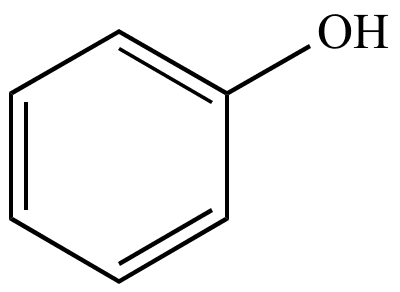
Phenol exhibits keto-enol tautomerism with its unstable keto tautomer cyclohexadienone, but only a tiny fraction of phenol exists as the keto form. The equilibrium constant for enolisation is approximately 10−13, meaning that only one in every ten trillion molecules is in the keto form at any moment. The small amount of stabilisation gained by exchanging a C=C bond for a C=O bond is more than offset by the large destabilisation resulting from the loss of aromaticity. Phenol therefore exists essentially entirely in the enol form.
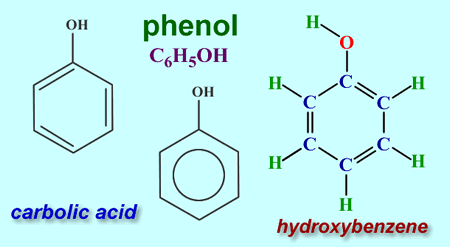
Phenoxides are enolates stabilised by aromaticity. Under normal circumstances, phenoxide is more reactive at the oxygen position, but the oxygen position is a "hard" nucleophile whereas the alpha-carbon positions tend to be "soft".
Reactions
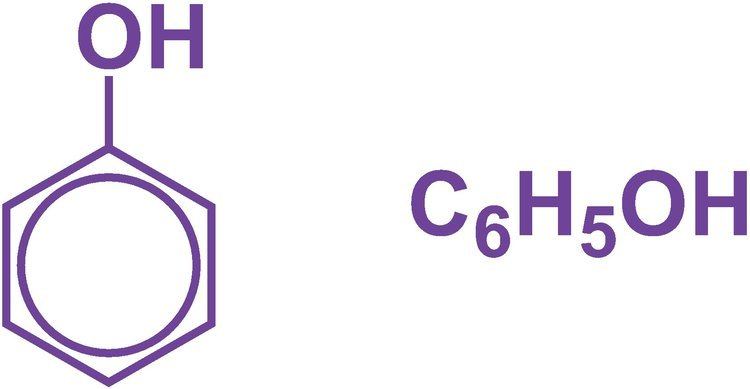
Phenol is highly reactive toward electrophilic aromatic substitution as the oxygen atom's pi electrons donate electron density into the ring. By this general approach, many groups can be appended to the ring, via halogenation, acylation, sulfonation, and other processes. However, phenol's ring is so strongly activated—second only to aniline—that bromination or chlorination of phenol leads to substitution on all carbon atoms ortho and para to the hydroxy group, not only on one carbon. Phenol reacts with dilute nitric acid at room temperature to give a mixture of 2-nitrophenol and 4-nitrophenol while with concentrated nitric acid, more nitro groups get substituted on the ring to give 2,4,6-trinitrophenol which is known as picric acid.
Aqueous solutions of phenol are weakly acidic and turn blue litmus slightly to red. Phenol is easily neutralized by sodium hydroxide forming sodium phenate or phenolate, but being weaker than carbonic acid, it cannot be neutralized by sodium bicarbonate or sodium carbonate to liberate carbon dioxide.
C6H5OH + NaOH → C6H5ONa + H2OWhen a mixture of phenol and benzoyl chloride are shaken in presence of dilute sodium hydroxide solution, phenyl benzoate is formed. This is an example of the Schotten-Baumann reaction:
C6H5OH + C6H5COCl → C6H5OCOC6H5 + HClPhenol is reduced to benzene when it is distilled with zinc dust. The same when phenol vapour is passed over granules of zinc at 400 °C:
C6H5OH + Zn → C6H6 + ZnOWhen phenol is reacted with diazomethane in the presence of boron trifluoride (BF3), anisole is obtained as the main product and nitrogen gas as a byproduct.
C6H5OH + CH2N2 → C6H5OCH3 + N2When phenol reacts with iron(III) chloride solution, an intense violet-purple solution is formed.
Production
Because of phenol's commercial importance, many methods have been developed for its production. The dominant current route, accounting for 95% of production (2003), is the cumene process, which involves the partial oxidation of cumene (isopropylbenzene) via the Hock rearrangement:
C6H5CH(CH3)2 + O2 → C6H5OH + (CH3)2COAcetone is produced as a by-product. Compared to most other processes, the cumene process uses relatively mild synthesis conditions, and relatively inexpensive raw materials. However, to operate economically, there must be demand for both phenol, and the acetone by-product.In 2010, worldwide demand for acetone was approximately 6.7 million tonnes, 83 percent of which was satisfied with acetone produced by the cumene process.
An early commercial route, developed by Bayer and Monsanto in the early 1900s, begins with the reaction of a strong base with benzenesulfonate:
C6H5SO3H + 2 NaOH → C6H5OH + Na2SO3 + H2OOther methods under consideration involve:
In the Lummus Process, the oxidation of toluene to benzoic acid is conducted separately.
Phenol is also a recoverable byproduct of coal pyrolysis.
Uses
The major uses of phenol, consuming two thirds of its production, involve its conversion to precursors for plastics. Condensation with acetone gives bisphenol-A, a key precursor to polycarbonates and epoxide resins. Condensation of phenol, alkylphenols, or diphenols with formaldehyde gives phenolic resins, a famous example of which is Bakelite. Partial hydrogenation of phenol gives cyclohexanone, a precursor to nylon. Nonionic detergents are produced by alkylation of phenol to give the alkylphenols, e.g., nonylphenol, which are then subjected to ethoxylation.
Phenol is also a versatile precursor to a large collection of drugs, most notably aspirin but also many herbicides and pharmaceutical drugs. Phenol is also used as an oral anesthetic/analgesic in products such as Chloraseptic or other brand name and generic equivalents, commonly used to temporarily treat pharyngitis.
Phenol is a component in liquid/liquid phenol–chloroform extraction technique used in molecular biology for obtaining nucleic acids from tissues or cell culture samples. Depending on the pH of the solution either DNA or RNA can be extracted.
Niche uses
Phenol is so inexpensive that it attracts many small-scale uses. It once was widely used as an antiseptic, especially as carbolic soap, from the early 1900s to the 1970s. It is a component of industrial paint strippers used in the aviation industry for the removal of epoxy, polyurethane and other chemically resistant coatings.
Phenol derivatives are also used in the preparation of cosmetics including sunscreens, hair colorings, and skin lightening preparations.
Concentrated phenol liquids are commonly used for permanent treatment of ingrown toe and finger nails, a procedure known as a chemical matrixectomy. The procedure was first described by Otto Boll in 1945. Since that time it has become the chemical of choice for chemical matrixectomies performed by podiatrists.
Phenol spray is used medically to help sore throat.
Phenol is the active ingredient in some oral analgesics such as Chloraseptic spray and Carmex.
History
Phenol was discovered in 1834 by Friedlieb Ferdinand Runge, who extracted it (in impure form) from coal tar. Runge called phenol "Karbolsäure" (coal-oil-acid, carbolic acid). Coal tar remained the primary source until the development of the petrochemical industry. In 1841, the French chemist Auguste Laurent obtained phenol in pure form.
In 1836, Auguste Laurent coined the name "phène" for benzene; this is the root of the word "phenol" and "phenyl". In 1843, French chemist Charles Gerhardt coined the name "phénol".
The antiseptic properties of phenol were used by Sir Joseph Lister (1827–1912) in his pioneering technique of antiseptic surgery. Lister decided that the wounds themselves had to be thoroughly cleaned. He then covered the wounds with a piece of rag or lint covered in phenol, or carbolic acid as he called it. The skin irritation caused by continual exposure to phenol eventually led to the substitution of aseptic (germ-free) techniques in surgery.
Phenol was the main ingredient of the Carbolic Smoke Ball, an ineffective device marketed in London in the 19th century as protection against influenza and other ailments, and the subject of the famous law case Carlill v Carbolic Smoke Ball Company.
Second World War
The toxic effect of phenol on the central nervous system, discussed below, causes sudden collapse and loss of consciousness in both humans and animals; a state of cramping precedes these symptoms because of the motor activity controlled by the central nervous system. Injections of phenol were used as a means of individual execution by the Nazis during the Second World War. It was originally used by the Nazis in 1939 as part of Action T4. The Nazis learned that extermination of smaller groups was more economical by injection of each victim with phenol. Phenol injections were given to thousands of people. Approximately one gram is sufficient to cause death.
Natural occurrences
Phenol is a normal metabolic product, excreted in quantities up to 40 mg/L in human urine.
The temporal gland secretion of male elephants showed the presence of phenol and 4-methylphenol during musth.
It is also one of the chemical compounds found in castoreum. This compound is ingested from the plants the beaver eats.
Occurrence in whisky
Phenol is a measurable component in the aroma and taste of the distinctive Islay scotch whisky, generally ~30 ppm, but it can be over 160ppm in the malted barley used to produce whisky. This amount is different from and presumably higher than the amount in the distillate.
Biodegradation
Cryptanaerobacter phenolicus is a bacterium species that produces benzoate from phenol via 4-hydroxybenzoate. Rhodococcus phenolicus is a bacterium species able to degrade phenol as sole carbon sources.
Toxicity
Phenol and its vapors are corrosive to the eyes, the skin, and the respiratory tract. Its corrosive effect on skin and mucous membranes is due to a protein-degenerating effect. Repeated or prolonged skin contact with phenol may cause dermatitis, or even second and third-degree burns. Inhalation of phenol vapor may cause lung edema. The substance may cause harmful effects on the central nervous system and heart, resulting in dysrhythmia, seizures, and coma. The kidneys may be affected as well. Long-term or repeated exposure of the substance may have harmful effects on the liver and kidneys. There is no evidence that phenol causes cancer in humans. Besides its hydrophobic effects, another mechanism for the toxicity of phenol may be the formation of phenoxyl radicals.
Since phenol is absorbed through the skin relatively quickly, systemic poisoning can occur in addition to the local caustic burns. Resorptive poisoning by a large quantity of phenol can occur even with only a small area of skin, rapidly leading to paralysis of the central nervous system and a severe drop in body temperature. The LD50 for oral toxicity is less than 0.5 mg/kg for dogs, rabbits, or mice; the minimum lethal human dose was cited as 140 mg/kg. The Agency for Toxic Substances and Disease Registry (ATSDR), U.S. Department of Health and Human Services states the fatal dose for ingestion of phenol is from 1 to 32 g.
Chemical burns from skin exposures can be decontaminated by washing with polyethylene glycol, isopropyl alcohol, or perhaps even copious amounts of water. Removal of contaminated clothing is required, as well as immediate hospital treatment for large splashes. This is particularly important if the phenol is mixed with chloroform (a commonly used mixture in molecular biology for DNA and RNA purification). Phenol is also a reproductive toxin causing increased risk of abortion and low birth weight indicating retarded development in utero.
Phenols
The word phenol is also used to refer to any compound that contains a six-membered aromatic ring, bonded directly to a hydroxyl group (-OH). Thus, phenols are a class of organic compounds of which the phenol discussed in this article is the simplest member.
